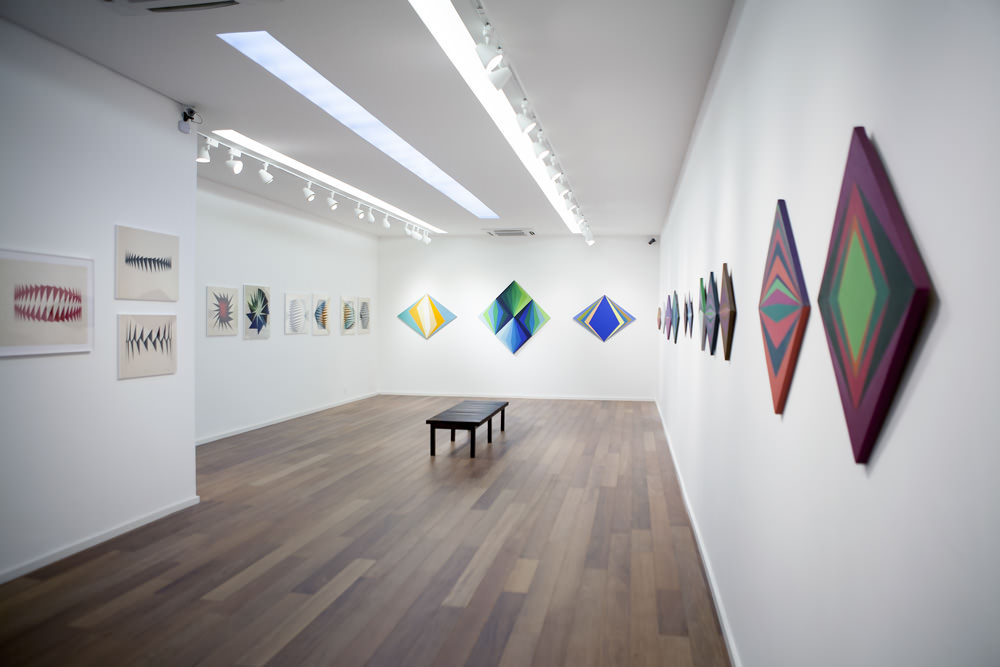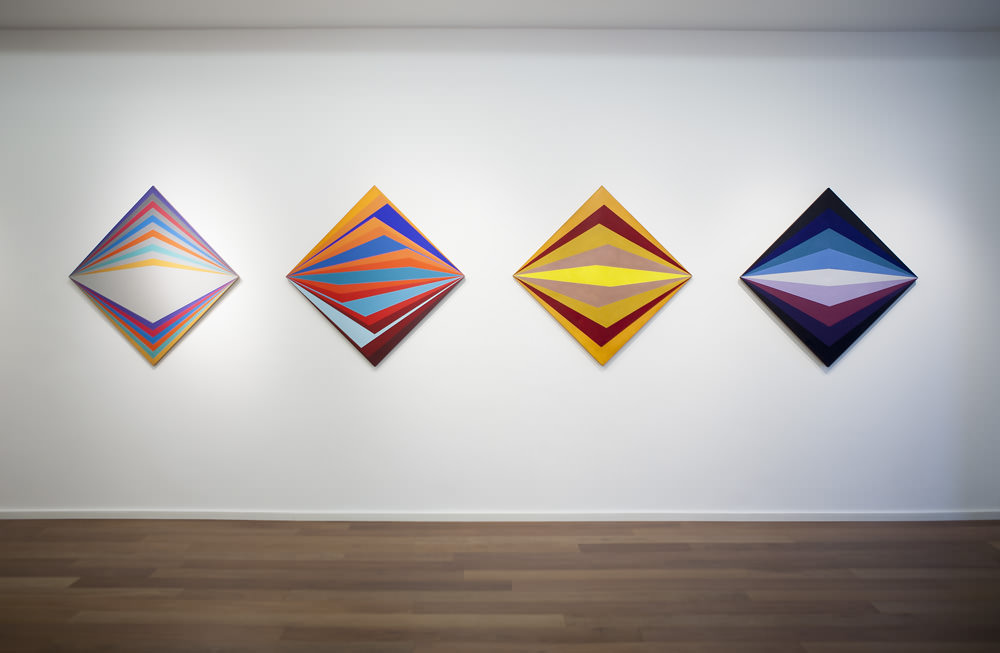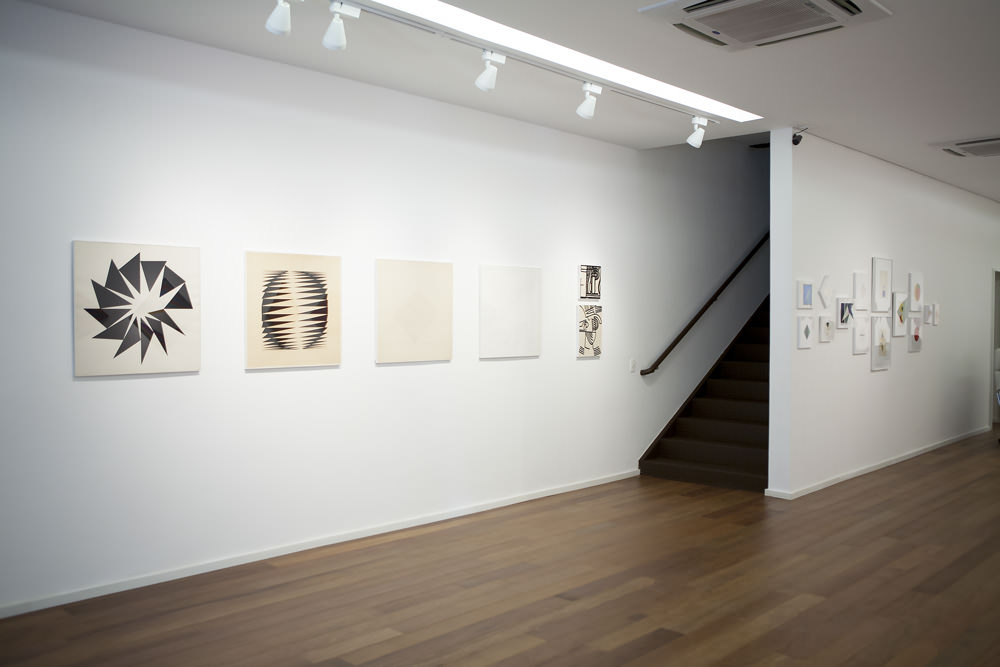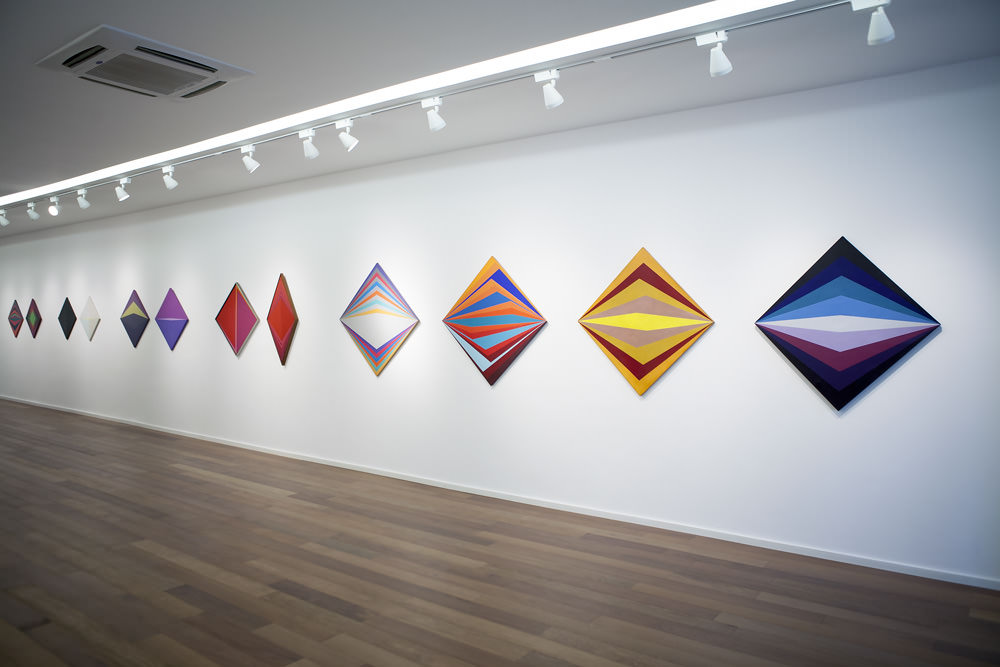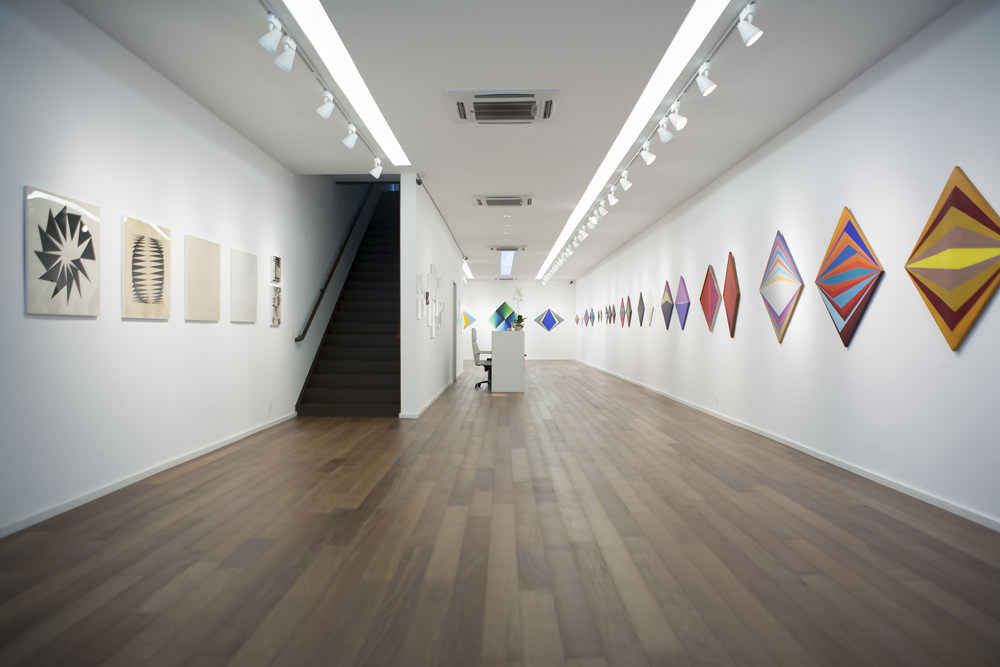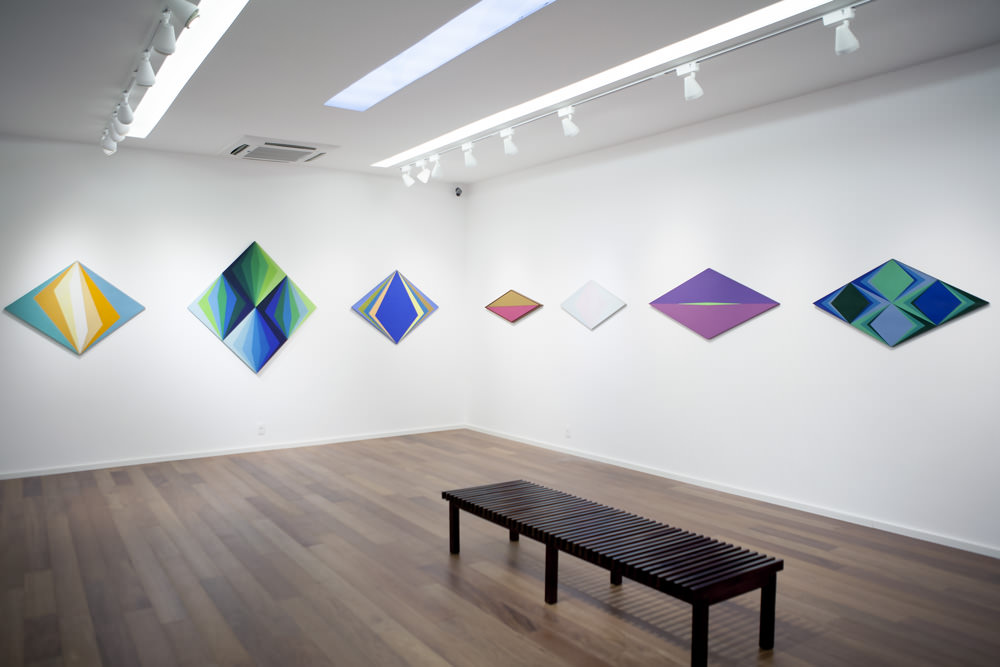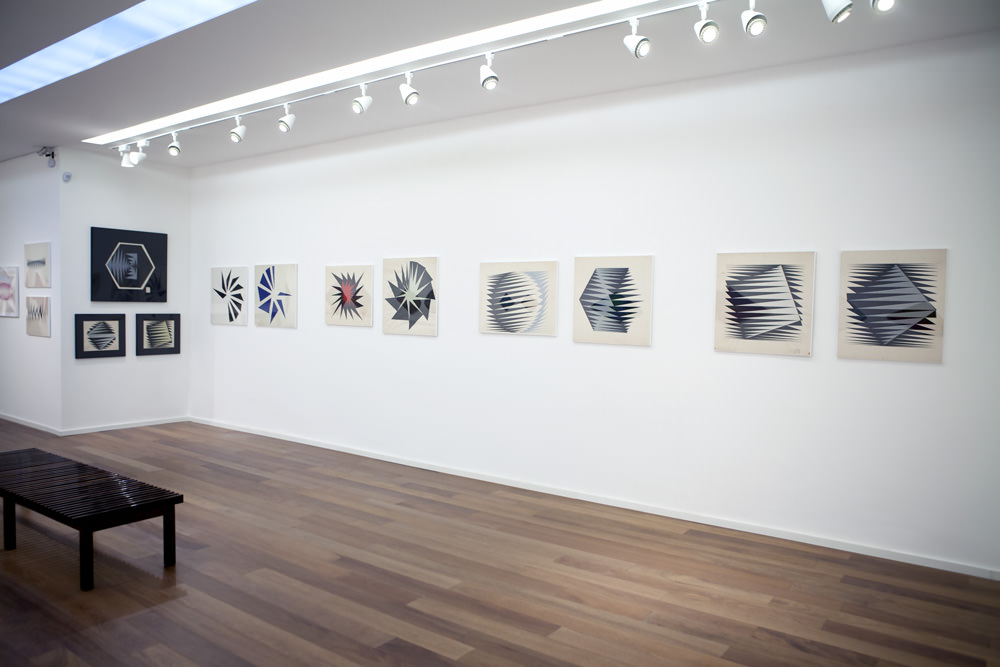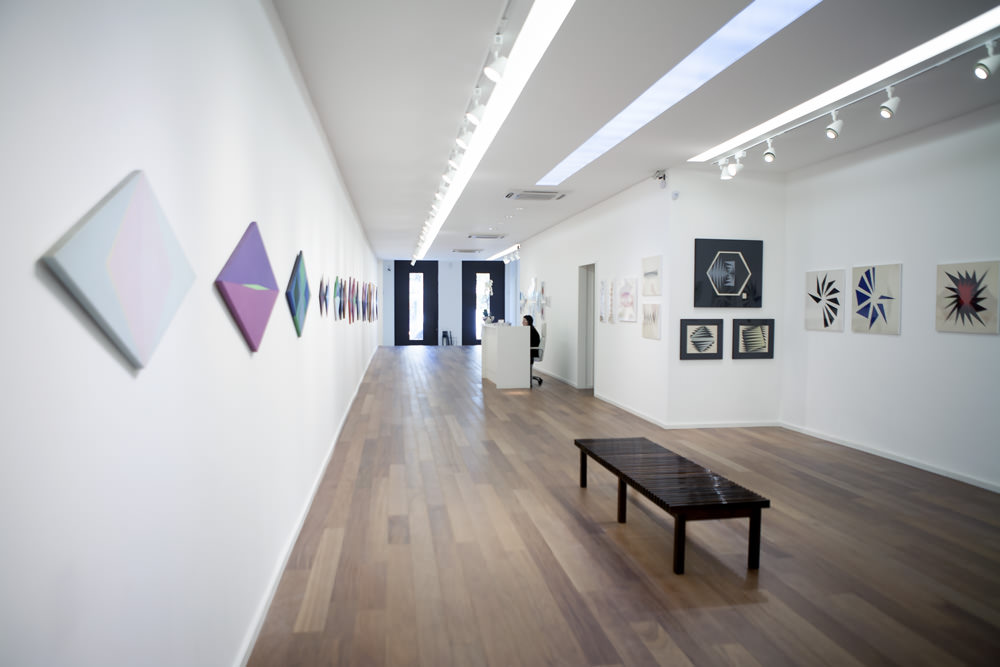Hércules Barsotti
Determining Opposites
HÉRCULES BARSOTTI
Hércules Barsotti is an artist who, since the beginning of his work, has explored the different configurations of space, rigorously utilizing the possibilities of color and form, which led to innovative perspectives on painting itself as a poetic medium.
He presented himself as a painter and graphic designer. During his training as a painter, he was mentored by the Italian artist and professor at the Lyceum of Arts and Crafts, Enrico Vio, from 1932 to 1934. In those classes, Barsotti sought to learn painting and drawing techniques, but his research differed profoundly from that of his teacher, as Vio neither aligned himself with nor was influenced by the modernist trends widely debated in our cultural and artistic circles, especially in the city of São Paulo.
Other forms of learning and artistic interaction with his peers also expanded his repertoire in the visual realm. In an interview given to the MAM-SP magazine in 1999, Barsotti himself expressed this when he stated that he started out like everyone else. He became interested in painting and began to create and study it. The artist says that "I had a friend who was a painter, Dario Mecatti, very skilled, with great technique, but not very creative, (...): he painted a lot from nature, figures, things like that. One day he invited me to paint something too. He threw a bunch of grapes on a table. But it wasn't creative, it was a reproduction of nature" (Barsotti, 1998).
Barsotti's artistic research led him to experiment with some trends that were being discussed and used by São Paulo artists. One of these was surrealism, whose principles attracted the attention of artists linked to the modernist movement and subsequent generations, such as Tarsila do Amaral, Ismael Nery, Cícero Dias, and Maria Martins, among others. In the aforementioned interview, Barsotti confirms that he moved "from natural painting to surrealism." But he then states that "it wasn't quite what he wanted" (Barsotti, 1998).
By looking at these paintings and drawings (such as the drawings Untitled, India ink on paper, 1952 and Composition, oil on canvas, 1953), we notice that the question of structure and space was already present in the way visual elements were arranged on the picture plane. His choice of a version of surrealism linked to the metaphysical trend can be interpreted as indicating a propensity for spatial organization through the order applied to the composition, which, in a way, suggests a concern with rationality and geometricization. In such works, the voids, the use of colors—few and subtle—and proportion are ordered with a clear attention to the balance of forms and their conformation and relationship to space. In this regard, it is also worth noting that, in the work Composition, from 1953, the human element, although placed in the foreground, does not suggest any conceptual exploration of a humanist nature, but, on the contrary, seems to accentuate and organize the distribution of the composition's elements.Although his first paintings date from the 1940s, it was throughout the 1950s that Barsotti executed his first abstract-geometric drawings. In these drawings, from an early phase of his connection with abstraction, we clearly see a concern with the interplay between forms and space, in which he explores some possibilities of geometry, but still without the rigor of his later works, of a Neoconcrete nature.
In drawings such as Untitled, ink on paper, 1956 and Black and White Geometric Figure, ink on paper, 1956, we see the artist exploring connections between form and movement on the plane. However, in some, we still encounter a suggestion of figures and even landscapes that stand out from the plane. Furthermore, these drawings lack the constructive rigor he explored in his works shortly thereafter. The lines, of varying dimensions, accentuate movement while simultaneously circumscribing spaces.
From this production, in which movement is given by curves and variations of line, to the more geometrical one, there is little temporal distance. Barsotti quickly began to use geometric forms in arrangements through which he constructed, reconstructed, and deconstructed space, creating a play between the containing and the contained forms.
Once again, we give voice to the artist who indicates the paths he took until he found his definitive affinity with the concrete and neoconcrete movements. He says that "there was the I São Paulo Biennial in 1951, there in the Trianon building, and a group of Swiss artists came with a very constructed, very geometrical work, which attracted and influenced me greatly. I continue in this vein to this day" (Barsotti, 1998). Indeed, with his reflection over a reasonable period of time between his work in the 1950s, his testimony, and subsequent work until the end of his life, it can be said that Barsotti remained faithful to the principles of construction.
A key figure in Hércules Barsotti's journey toward producing work based on structure and geometry is Willys de Castro. Both frequented the São Paulo Museum of Modern Art when it was still located on Sete de Abril Street. The artists' friendship led to the creation, in 1954, of the Graphic Design Studio, where they worked over the course of ten years on a large number of projects that brought them increasingly closer to geometric rigor, without, however, making their work overly calculated.
This pursuit of precision in the work of both artists was so consistent that it became the subject of an essay by Pietro Maria Bardi, which discusses not the work or the graphic designs, but the designs they both produced for the textile industry. To emphasize his concern for such precise and assertive production, Bardi discusses the studio where the artists worked. In a note published in the Diário de São Paulo in July 1967, Bardi compares the duo Willys and Barsotti to Lord Brummel, a London dandy considered the arbiter of fashion in his time. He says that, just as for Brummel, a suit and accessories were conceived as a work of art and wearing one a religious act—for the duo W&B, the making of an object was also a religious act. Bardi states that he saw in them "the same belief in an attitude, in a style, the courage to defend it, the fidelity to millimeter precision, even to the pretentiousness of a total consideration of every subtlety." Their studio is organized in a logarithmic order. The first time we entered, we looked at the floor to see if we should put on slippers so as not to disturb the waxed floor. (...) Willys and Barsotti don't let us notice anything strange in the studio: the placement, the space, the objects, the shapes, the colors, everything is in obedience to a style of artist-artists" (Bardi, 1967). These observations were made based on Bardi's contact with the drawings made by the duo for Rhodia.
The late 1940s and early 1950s were quite fruitful for art, as they were the period in which art and modern art museums were created, especially the MAM-SP, with its International Art Biennial. In this environment of heated debate and the construction of a more solid art system in the country, artists were placed at the epicenter of controversies about art. Some disputes between figurative and abstract, informal and formalistic abstract, and also between concrete and neoconcrete became historic.
Since the "Neoconcrete Manifesto," published in 1959, there had been a heated discussion among artists about their understanding of what art should be and its forms of expression in a rapidly changing world that suggested new sensibilities. These debates were punctuated by two important protagonists: Ferreira Gullar, on behalf of the Neoconcrete, and Waldemar Cordeiro, on behalf of the Concrete. The aesthetic and philosophical choices of Barsotti and Willys de Castro placed them close, above all, to the Neoconcrete group.
Like Hércules Barsotti and Willys de Castro, Theon Spanudis—one of the signatories of the "Neoconcrete Manifesto"— – had in common with them the fact that they did not align with the assumptions of concretism advocated in São Paulo, based on the initiative of the Ruptura Group, which, in addition to Cordeiro, included artists Lothar Charoux, Luiz Sacilotto, Geraldo de Barros, Kazmer Féjer, Anatol Wladyslaw, and Leopoldo Haar at its founding.
Therefore, it is not surprising to understand why Barsotti and Willys de Castro were invited by Ferreira Gullar to exhibit alongside the Neoconcrete artists of Rio de Janeiro at the anthological 2nd and 3rd Neoconcrete Art Exhibitions, held at the Ministry of Education (1960) and the Museum of Modern Art (1961), respectively.
This alignment with the assumptions of Neoconcretism gave Barsotti great freedom of experimentation. The period spanning the entire 1950s was quite fruitful for the artist, as it was when he defined his objects of interest within the realm of visuality and developed his own grammar, which he expanded and strengthened as a language throughout the following decades, especially during the 1960s and 1970s, when he exhibited more regularly and had the opportunity to show his work in Brazil and abroad.
The works produced throughout the 1950s and early 1960s were done solely in black and white. His approach to color occurred in 1963. Barsotti said: "When I painted form, I wasn't interested in color. I painted only in black and white with paints that dried quickly. This was around the end of 1950. In 1963, I saw in an American magazine that they had discovered a paint, vinyl acrylic. (...) When I started in black and white, I made very simple forms. Then, with color, the form was enriched. "Over time, I returned to simplicity" (Barsotti, 1998).
The introduction of color was fundamental to his work. Furthermore, geometry, applied to the forms inscribed in drawings and paintings, extended to the very format of the support with the use of diamond-shaped, round, triangular, hexagonal, pentagonal, and square canvases, accentuating the artistic themes suggested by the artist.
His research continued to deepen, creating a very consistent and coherent body of work.
Form and space
The question of form, and especially geometric form, is fundamental in Barsotti's work. Both the configuration and the size of the geometric figures revealed engender an association with their positioning in the pictorial space. This procedure brings to consciousness, through angles and inclinations, movements that suggest an architectural spatiality.
Flat figures are part of a resource frequently used by the artist to define his pictorial space. Although the question of delimiting spaces is a constant, Barsotti blurred the line with the use of color or the contrast of black and white. He constructed geometric figures that, through the modulation of angles and within the framing provided by the limits of the canvas, rather than appearing flat, engender the visual perception of geometric figures projected in space. This visual result occurs through a powerful confrontation of the figures without resorting to any cognitive illusion. Geometric figures circumscribe areas and, at the same time, structure them.
Some apparent qualities of forms, or what might be called a configuration of visual forces that occur in the relationship between lines and volumes and their structural organization, allow their distribution on the two-dimensional plane to affect us directly and profoundly.
Barsotti is an artist strongly aware that, in its relationship to space, the physiognomy of a visual form, whether in his drawings or paintings, is not always the same. The operation by which the artist tilts the forms—squares, triangles, semicircles, among others—and arranges them on the picture plane is extremely calculated, both in their relationship to the frame and in the broader context, which considers the field of space surrounding the work and its relationship to the external world—that is, its relationship and confrontation with other works, with the exhibition space, and with its contextual positioning. The result of this procedure demands the constant search for new conditions for the assimilation of its perceptive qualities, which, by connecting with the external world, reinforce the presence of the work, circumscribed in its individuality.
The artist intelligently explores the principle by which the inclinations of the composition's elements do not interfere with the structure of the form itself, but rather immensely alter our perception. This results in our observation being constantly challenged by the surprising new relationships possible to the eye and our distinct ways of assimilating the work, naturally requiring a reflective stance toward it.
Another fundamental strategy in Barsotti's artistic work is the use of canvases whose formats are not limited to that of the traditional "picture." In traditional drawing and painting, the concept of a picture refers to a section that prescribes a vertical plane for the projection of an image. The issue of perspective, questioned and often challenged by modern and contemporary art, has turned the picture plane into a space for experiments. When he opts for canvases in unusual formats, while maintaining defined geometric forms, such as circles, triangles, pentagons, hexagons, diamonds, among others, Barsotti intensifies his procedure in which the relationship between the planes and their connection to the pictorial space projects spaces organized by elements that allow the parts to relate to possible architectures. If, on the one hand, the artist acts within the realm of painting and explores all its possibilities, on the other, he intensely reveals that his form, distinct from the traditional rectangular or square frame, results in a necessary change in the correlation established as a delimiting space for the figures painted on the surface of the canvas. However, the relationship of painting as a projection in space is determined by such limits. The canvas, as a larger contour, in its relationship with geometric forms, modulates the surrounding space. The unusual aspect of his canvases acts as a projection and operates with perceptive relationships in such a way as to question the two-dimensional characteristics of the canvas. His forms are so powerful that they launch us into the question of their presence as an object and, therefore, as a three-dimensional presence. Furthermore, such formats emphasize the relationship of the parts to the whole. We then move on to considerations that include relationships of measurement and amplitude of angles and the creation of areas delimited by surfaces and, thus, enter into the question of volumes and space.
One of his constants in the process of intervening in the logic of the painting is the inversion of the square canvas and its "transformation" into a diamond. In this process, another symmetry emerges with such intensity that a very pronounced dynamic arises as a result of a less stable gaze. The angles act as a way to accentuate the edges of the canvas, and in relation to the figures occupying the picture plane, the movement advocates various modular spaces. The work "Multileituras Opcionais," from 1974, is an excellent example of this strategy. In this work, the distinct angles of the triangular forms suggest superimpositions, layers, and volumes projected into space. On the other hand, the work Interconnected Concentrations I, also from 1974, which emphasizes the operation with the rhombus through the inversion of the internal geometric figures, also inverted squares and triangles, brings, in its relationship with color, a "quasi-balance" that is challenged with each new look. It is a work with an intense physical presence whose purpose, it seems to us, is to designate the properties related to the position and shape of objects in space and, simultaneously, to put them at risk through the operations derived from their visual perception. To this end, the simple forms on the plane, combined with their greatest resource—color—act in conjunction.
Color
We could consider the 1940s as a period in which Barsotti dedicated himself to understanding painting. His work from this period bears little connection to what followed when he chose to work based on Constructivist principles.
In the next phase, beginning with the works produced in the mid-1950s, the artist worked on his paintings and drawings using only black and white. In these paintings, which employed the oil-on-canvas technique, the predominance of form is accentuated by the contrasts between the elements placed on the plane. Although Barsotti emphasizes that, in these works, his interest was focused on the question of form, a practical aspect also led him to choose black and white. The artist said that "oil paint takes three or four days to dry, but black and white dried faster" (Barsotti, 2002).
The preference for black and white, which Ana Maria de Moraes Belluzzo calls non-color, may be associated, according to the author, with a "desire to qualify visuality." that Barsotti sought in his practice as a graphic artist. For Belluzzo, "it is likely that Barsotti's poetics emerged on the fringes of painting, which was strongly influenced by the graphic arts" (Belluzzo, 2004).
The visual results from the black and white series led him to expand his range of experiments, incorporating the use of sand on the painting to explore the issue of light through the shimmer and reflections it generated. Barsotti himself explained his process: "In the beginning, I worked with sand, enamel, and oil. For example, on a completely black canvas, I used oil paint on the smooth part. Where I added sand, I painted with enamel, and then threw the sand to make it stick. To color, I applied turpentine, which dissolved the enamel. This dissolution dyed the sand, but the quartz grains didn't absorb the color." (Barsotti, 2002).
The palette restricted to black and white and the use of sand underwent a profound change when Barsotti began using color for a practical purpose: the development and commercialization of acrylic-vinyl paint, which he discovered in 1963. From this point on, the artist produced some of the works that became a major reference in his work.
In these works, space and color are configured as intense perceptive media. The colors he used went beyond the contrasts between warm and cool, primary, secondary, and complementary. As we know, the issue of luminosity affects both the perception of color itself and that of space. Barsotti accentuated this procedure by using contrasts that indicate the relativity and imprecision of colors. His process is not the result of methods used to achieve optical effects, even though it is based on the qualities of color as a physical phenomenon. It involves considering color—or the visible spectrum—transmitted color—light—and reflected color. Barsotti worked with contrasts, albeit quite unusual ones due to the varying intensities or degrees of purity of the opposing colors. Furthermore, he utilized contrasts of distance, related to the strength of the color in question, and, in some cases, simultaneous contrast, in which the combination of multiple colors created relationships and tensions. His most consistent practice, however, was the creation of defined areas on the plane that intensified with the use of color, reiterating his initial interest in form.
The artist's use of acrylic paint was also not haphazard. The painted surface became quite condensed and did not create fissures. Because of this homogeneity and regularity, Barsotti achieved in his work with color the full potential of a painting, at once rigorous and sensitive. Because the work dried quickly, the artist could apply multiple layers of color until achieving the desired intensity and texture, accentuating the boundaries of the forms and, consequently, the desired visual effects.
The artist resumed his use of sand in the 2000s, but this time he combined it with color for a radically different effect. In the canvases from this period, he glued the sand to the support and then applied acrylic paint. The hue of the sand altered the color on the sand, creating different hues of the same colors and distinct visual effects.
As the artist himself emphasized, the use of color led him to enrich the form. Indeed, movement occurred through the interaction of the colors that interacted, suggesting an intense movement that presented a wide range of sensory possibilities.
Color in Barsotti's work has such a striking presence that one could say he was a great colorist. But it's not just about coloring, but rather using color within the framework of a unique constructive grammar.Studies as a Project
The production of the historical European avant-garde movements inaugurated a new way of thinking about art that began with a break with traditional art. It proposed a major task: to transform art itself, aiming for a dialogue with the rapidly changing world around it, placing it as the driving force and intermediary of a new order that, it was hoped, would be more just.
In some of its branches, art became increasingly conceptual and self-reflective, as the idea of experimentation gained strength and was based on questions of method and its forms of application in the production of artistic objects. In this sense, the conception of a work of art based on a project seemed perfectly feasible.
Barsotti's studies can be seen as a system of reasoning about his chosen form of expression, which summarizes and materializes the artist's creative impulse, as well as its insertion into space and its form of elaboration. They include conceptualization stages in which graphic representations and excerpts identify the stages of development, production, and execution of a proposal that is structured and, therefore, materialized.
The choice of studies as a means of developing a creative project reveals the approach to its objects of interest—space, form, and color—whose visual results are evident.
Barsotti's studies partially demonstrate concepts expressed as a vector that channels the creative gesture and understands it as a necessary mediator between the idea and its materialization, its insertion into the world. In Barsotti, as in many artists of the Constructivist tendency, one perceives a valorization of the work process, of studies as a method of creation based on an emulating concept. In this sense, the visual and inventive quality present in his studies values his artistic creation as a process while also deeply and meaningfully articulating the elements that comprise the final work.
His studies do not subordinate intuition or subjectivity to concept or result, but rather seek to master such impulses in the pursuit of creating works that are simultaneously beautiful and vigorous and that respond to a rationality that allows for their realization. Through his studies, we see how Barsotti was an artist who combined visual culture with a highly intuitive process. Therefore, his distance from concrete assumptions and, consequently, his affinity with Neoconcretism become clear: it is not about prioritizing the rationality or functionality of a production. His studies can be thought of as a gesture mediated by consciousness and, therefore, as a form of intentional, non-gratuitous action.
Barsotti's studies echo his grammar in both drawings and paintings. In some, for example, there is a description of the use of colors and measurements, indicating a calculated precision in the use of pictorial space. They manifest the reasoning engendered based on a logic of production. Certainly, his work as a graphic artist, simultaneously with that of an artist, allowed both creative methods to harmonize. His studies developed a mental and pragmatic ordering of the artist's specific choices and procedures. But, beyond that, the care taken in their elaboration could well elevate them to the status of works of art, whether for their quality of production or their attention to detail.
The series as reflection
Hércules Barsotti, like many artists, worked with the principle of the series. He didn't necessarily do so in a calculated manner, with indicators of the beginning and end of specific artistic research. We can, however, define them based on a retrospective of his production: abstract paintings, paintings and drawings structured in black and white, paintings from the constructive phase using color and diamond-shaped frames, the return to paintings with color and sand.
The series, for contemporary art, has a primordial value of rupture. It is through this arrangement that the idea of a unique work is challenged. Thus, it becomes a practice that breaks with a tradition that links the principles of creation and execution of art as a singular act or, even, as singular derivations within a larger scope of inherited canons, and also with the definition of the work of art itself as such. The series, by its very logic, inserts the work of art into the realm of production due to its multiplicity. By analyzing Barsotti's work, we perceive how the series accentuates his artistic choices and, as a whole, allows us to observe how the arrangements proposed by the artist occur.
The concept of series, while close, should not be confused with those of repetition or accumulation, which are not coincidental and, ideologically, can even be antagonistic in their principles.
serialization allows for the imperative articulation of parts that engender a system. For this very reason, it ultimately becomes a form of artistic resistance against the possibility of reification in a universe dominated by excessive rationality and which determines a subordinate role for the subject. Barsotti's work process displayed a plastic rigor that simultaneously generated series and dealt with perceptions and sensations that distanced his work from argumentative redundancies.
Martin Heidegger (1966) suggested that meditative thought could be a necessary counterpoint to the constant celebration of the present. The author associated celebration with the absence of thought. He emphasized that "calculative thought," that is, the kind that allows a relationship in which technology and industry determine humanity's relationship to what already exists to prevail, subjugates humanity to a predetermined role in a world seen only as a source of energy. As a form of resistance to a purely celebratory state, Heidegger proposed a "meditative thought" against what he described as a "stampede of thinking," which led to the loss of rootedness (of humanity to its land) and the end of the autochthony of labor. Thus, he suggested, beyond a contentment with the affirmation of science and technology, a reflection on the new human insertion in this universe. Regarding the role of art, Heidegger stated that openness to understanding does not occur accidentally and, therefore, saw the creativity that produces lasting works as a way to forge new roots.
Considering Heidegger's view of the creative process and the role of art, one can consider that serialization—as a form of resistance—seems quite intriguing, since it allows art to confront the excessive technical rationality that ultimately promotes a state of absolute present. We further understand that Barsotti's creative process, although not ideologically intentional in this sense, was part of a highly self-critical moment in artistic production. His working method reinforced the understanding of the non-gratuitousness of the act of producing, viewing, and experiencing art.
Walter Benjamin (1985) noted that "social relations are (...) conditioned by relations of production." And when materialist criticism approached a work, it usually asked "how" that work stands before the social relations of production of the time. The author stated that it is necessary to advance this reasoning and, in doing so, he asked himself how a work stands within the relations of production, that is, he immediately pointed to the "technique" of production of works. For Benjamin, the concept of technique refers to that which makes works accessible to an immediately social analysis and, from this characteristic, to a materialist critique.
These arguments seem sufficient to consider the question of the series, especially in the work of Hércules Barsotti, as one of the possible forms of contemporary sensibility, adapted to new production standards both in industry and in what it ultimately proposes as a form of thought, permeating the various social, economic, political, and certainly artistic and cultural spheres that shaped the 20th century and with emanations that endure to this day. It is no coincidence that the artist's production in graphic arts informs his work as a painter and vice versa, in an amalgam of procedures closely related to his proposal, his sensitive operation, and the visual results of both.
It seems to us that serialization, as a process that leads to the possibility of a more attentive look, is quite suggestive insofar as it has the potential to critique a system from within, that is, from its insertion into such a universe. Furthermore, it is a great stimulus to consider Barsotti's work beyond its processes and visual results.
Barsotti's work demands time for observation and participation from the spectators, through which the works allow for revelations that lead us to a simultaneously sensitive and intellectual vision of the reality proposed by the work. In this case, the concept of "real" occurs in the sense of something connected to the idea of a presence as an object of interest for thought and, likewise, of its autonomy. In this way, Barsotti allows, through a visuality that occurs in space and time, a timely fusion between conscious perceptions and sensations. The artist's work, by instituting thought, is constantly updated and reinterpreted by this same thought. Above all, it is a profoundly stripped-down and beautiful production.
Sources:
Albers, Josef. The Interaction of Color. Original edition: 1963. Version by Maria Luisa. Balsiero, Alianza editorial, 1982, 3rd edition. Amaral, Aracy (supervision, coordination, and research). Brazilian Constructive Project in Art (1950-1962). Rio de Janeiro, Museum of Modern Art/São Paulo, State Art Gallery, 1977. p> Bardi, Pietro Maria. Willys de Castro and Barsotti. São Paulo Diary, July 9, 1967. p> Belluzzo, Ana Maria de Moraes. Brochure for the exhibition Hercules Barsotti: Non-Color-Color. Museum of Modern Art of São Paulo, September 24 to October 24, 2004.
Benjamin, Walter. “The Author as Producer.” In: Sociology. São Paulo, Ática, 1985.
Bittencourt, Eliana. Subtleties of Perception. Art Notebook, Exhibitions. Gazeta Mercantil, April 5, 6, and 7, 2002.
“Artists’ Testimonies: Hércules Barsotti and Luís Sacilotto.” MAM Magazine. Monthly magazine of the Museum of Modern Art of São Paulo, no. 2, year 1, December 1999.
Espada, Heloisa. Hércules Barsotti. Folha Collection. Great Brazilian Painters. São Paulo, Folha de São Paulo/Itaú Cultural Institute, 2013.
Heidegger, Martin. “Memorial Address”. In: Discourses on Thinking. New York, Harper Torchbooks, 1966.
By Marilúcia Bottallo
